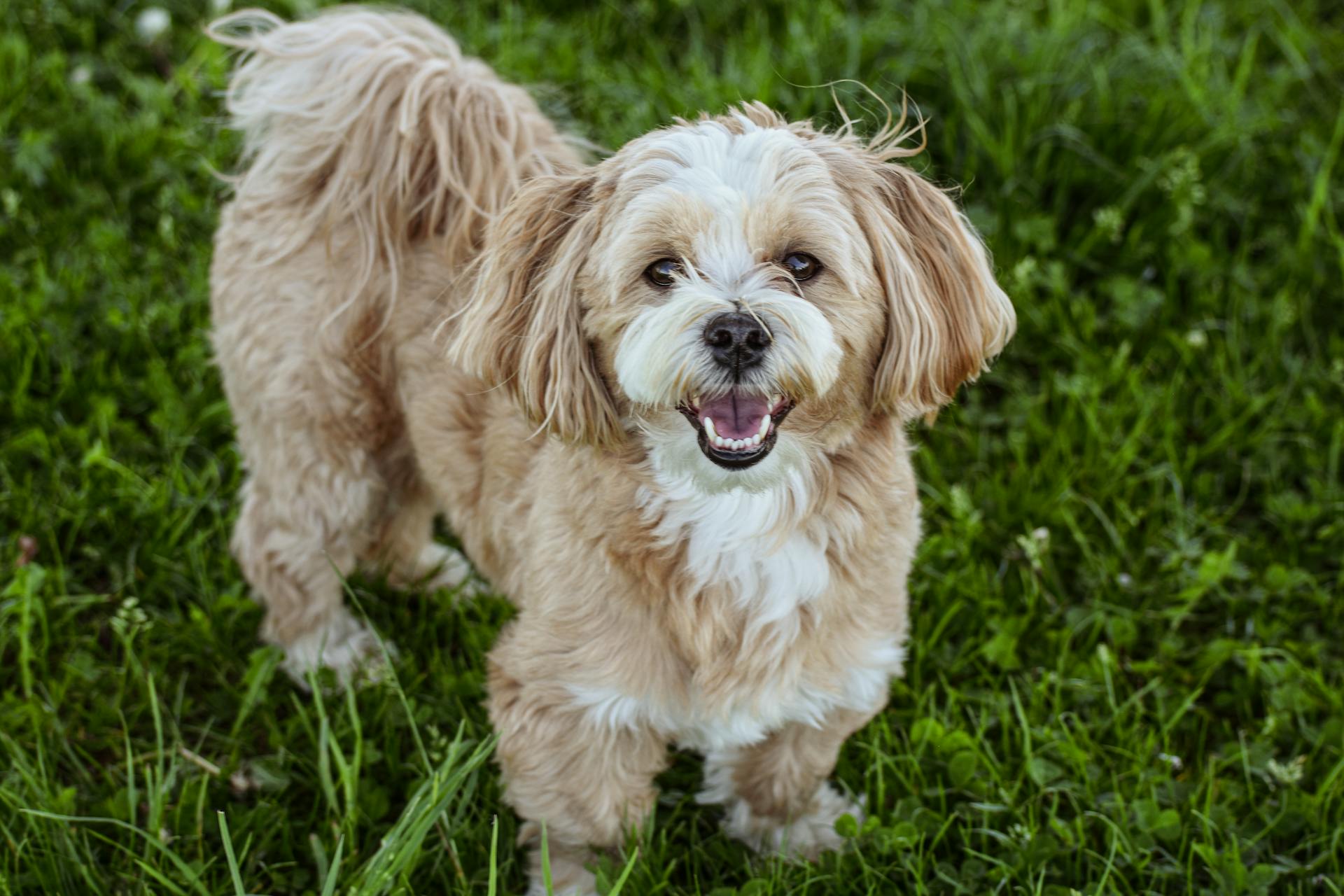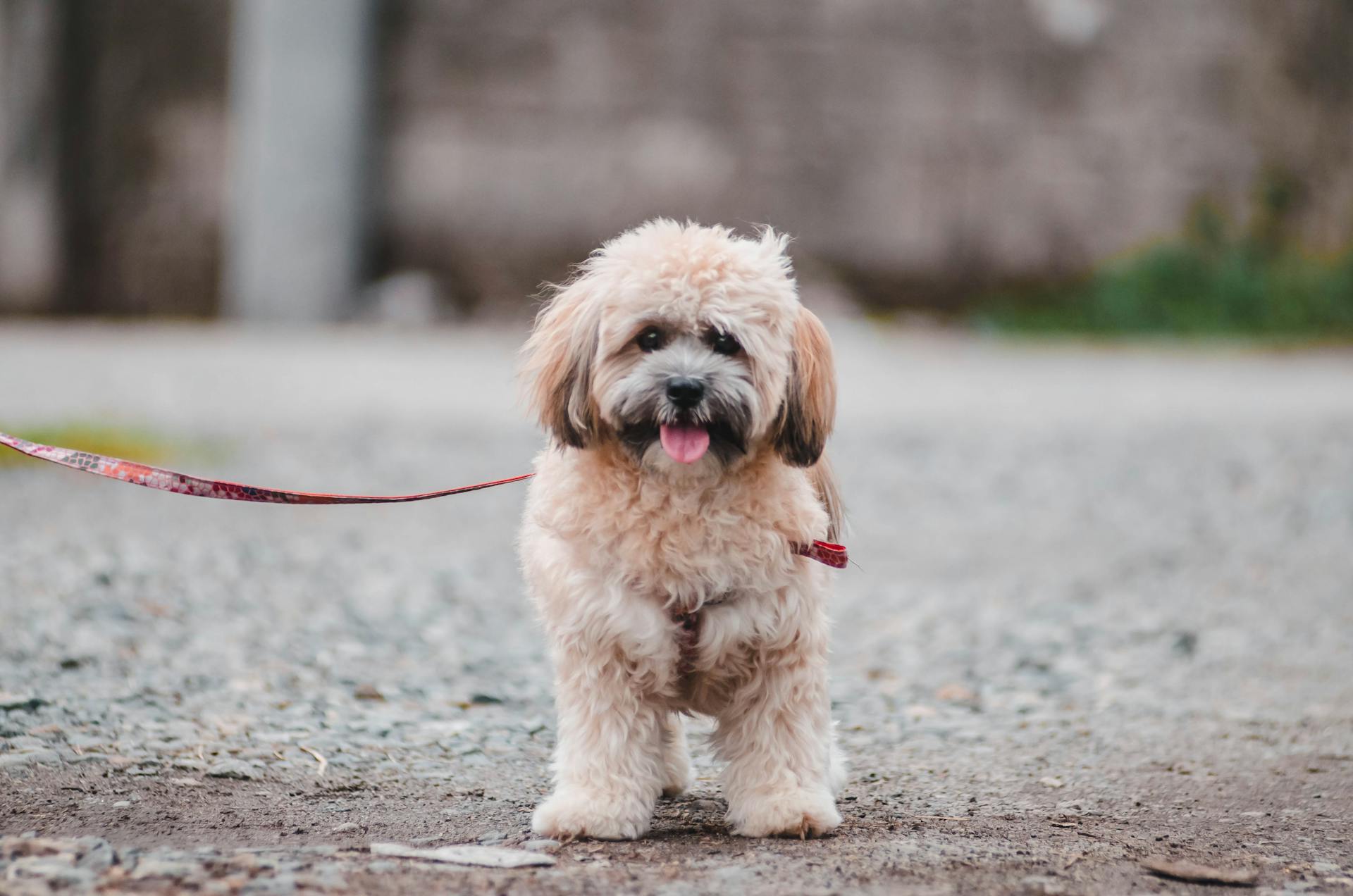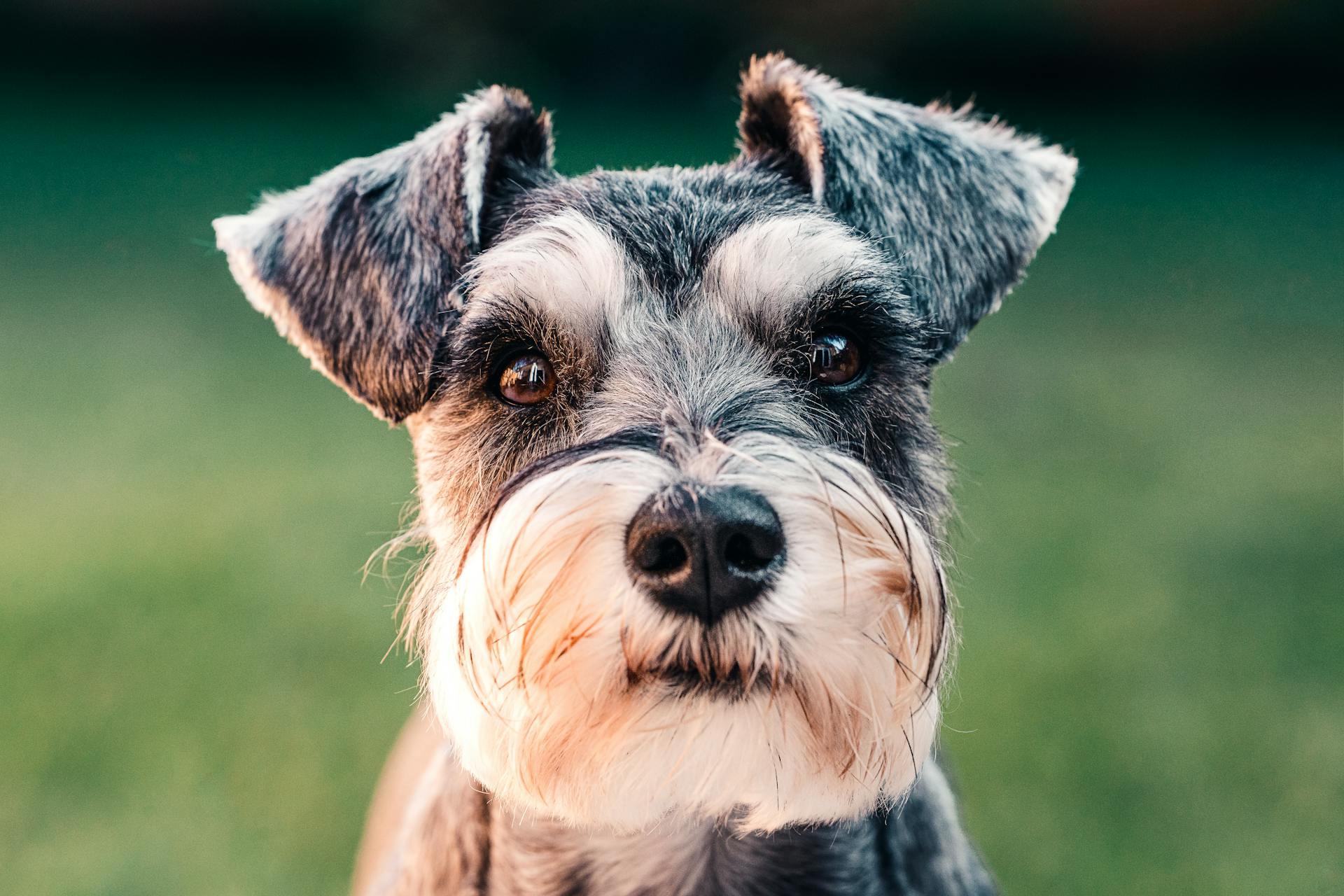
The Lhasa Apso is a small, fluffy dog breed that's steeped in history and tradition. Originally from Tibet, this breed was bred as a temple dog to guard the Dalai Lama.
They're known for their long, flowing coats that require regular grooming. Lhasa Apsos are also intelligent and loyal dogs, making them great companions.
Their small size, typically weighing between 13-18 pounds, makes them a great fit for city living or for families with smaller children.
Puppies
Getting a Lhasa Apso puppy can be a thrilling experience, but it's essential to do your research first.
Lhasa Apsos are a popular breed, so you may want to check your local shelter or a rescue organization before heading to a breeder.
If you do go the breeder route, make sure you’re using a reputable one, as they will provide a healthier puppy.
Lhasa Apsos are on the pricier side, so be wary of breeders trying to sell you one for cheap.
These dogs will be super affectionate right off the bat, as well as playful.
One important thing to know before bringing a Lhasa Apso home is that this breed is quite vocal, so expect plenty of barking.
You'll need to begin training them right away if you want your pup to bark less.
Temperament & Intelligence
The Lhasa Apso is a confident breed that believes it's much larger and tougher than it actually is. They're known as "abso seng kye" or "bark lion sentinel dog" in Tibet.
Their confidence is great, but it also means they can be independent and go their own way at times. This independence, combined with their high intelligence, makes them a challenging breed to train.
Lhasa Apsos are intensely devoted and loyal to their people, but this loyalty can also make them stand-offish with strangers. They'll always have your back, though.
They're also family comedians, always up for affection and playtime - but on their own terms. You'll want to start socialization early to help them be welcoming to strangers.
Lhasa Apsos typically mature emotionally between 1-3 years old, so be patient with your pup as they grow. With consistent training and praise, you can channel their energy into learning new things.
Their high intelligence and independent nature can make them stubborn, so they need consistent training to be well-behaved members of the family.
Care and Maintenance
Daily brushing is a must for Lhasa Apsos with long coats, as it prevents tangles and mats from forming.
You can brush your Lhasa Apso's coat daily with a comb and a stiff brush, or have a groomer cut their coat every couple of weeks to keep it shorter.
Their nails need to be trimmed regularly, about once a month, depending on their activity level.
You should also brush their teeth daily, starting as a puppy, and get an annual professional teeth cleaning by your vet.
Bathing your Lhasa Apso every two to four weeks is a good rule of thumb, or every four to six weeks if they have long hair.
Their ears, paws, eyes, and nose need to be checked weekly for signs of irritation.
Related reading: Dogo Argentino Teeth
Care and Maintenance

To keep your Lhasa Apso's coat healthy and shiny, be sure to brush them regularly, ideally 2-3 times a week. This will help prevent matting and tangling.
Their thick coats do require regular grooming, but they don't need to be bathed too frequently, just as needed. You'll know it's time for a bath when they start to smell or look dirty.
Lhasa Apsos are relatively low-maintenance pets, but they do need regular exercise to stay happy and healthy. A daily walk and some playtime should suffice.
Their diet is also crucial, so be sure to feed them high-quality dog food with plenty of protein and fats, aiming for a fat content of 14% or higher. This will help support their thick coats.
Even a little overeating can cause digestive issues in Lhasa Apsos, so be mindful of their food portions and avoid giving them too many treats.
You might like: When Will Shiba Inu Hit $1
Exercise
Exercise is a crucial part of a Lhasa Apso's care, but don't worry, they don't need a marathon runner's endurance. A daily walk of 15-30 minutes should be plenty to keep them happy and healthy.
These dogs are not built for speed, so a leisurely stroll is perfect for them. They'll likely be tuckered out after about 20 minutes of walking, running, or playing.
If you want to give your Lhasa Apso a bit more exercise, consider setting up an agility course or playing fetch in the backyard. They love to run around and burn off energy.
Having plenty of toys on hand is also a great way to provide mental and physical stimulation for your Lhasa Apso. It's essential to keep them engaged and curious about the world around them.
Play dates with other pups are also a great way to socialize your Lhasa Apso and give them some exercise. Just remember to keep it fun and not too strenuous.
Grooming
Grooming is a crucial part of Lhasa Apso care and maintenance. Regular grooming helps prevent tangles and mats from forming in their long coat.
Daily brushing is required to prevent tangles and mats from forming in a Lhasa Apso's long coat. You can use both a comb and a stiff brush for this.
A bi-monthly bath is recommended for Lhasas with long coats. Brushing your pet before bathing them is essential to prevent tangles or mats from forming in their hair.
Non-coat-related grooming includes keeping your pup's nails trimmed and brushing their teeth on a regular basis. You should also check your dog's ears, paws, eyes, and nose each week for signs of irritation.
A Lhasa Apso's nails need to be cut on a regular basis, about once a month, depending on how active your pup is. You'll know it's time when you hear the familiar tap-tap-tap on your hardwood and tile floors.
Brushing your dog's teeth daily is essential, but start with a puppy and work up to it. Use dog toothpaste, as human toothpaste is toxic for dogs!
Regular grooming helps prevent shedding and keeps your Lhasa Apso looking its best.
Health and Environment
Lhasa Apsos are generally healthy dogs, but they can be prone to certain health issues. They have a lifespan of 12 to 15 years, but with proper care, some have even been known to live into their 20s.

Their thick coat keeps them warm in colder climates, but it requires regular grooming to prevent matting and tangling. If you live in a warm climate, you can easily keep their coat short.
Lhasa Apsos can suffer from dental disease, with over 80% of dogs over 3 years old developing the condition. To prevent this, brush your dog's teeth daily and get annual dental cleanings from your vet.
Here are some common health issues that can affect Lhasa Apsos:
- Hereditary Kidney Dysfunction: a condition where the kidneys do not develop properly and can lead to kidney failure at a young age.
- Dental Disease: a condition that can lead to tooth loss, painful gums, and systemic problems.
- Eye Problems: Lhasa Apsos are susceptible to conditions like cherry eye, dry eye, and progressive retinal atrophy (PRA).
- Patellar Luxation: a condition where the kneecap slips out of place, causing pain and arthritis.
In warmer climates, it's essential to keep Lhasa Apsos' exercise to cooler parts of the day to prevent breathing difficulties. They may not need a lot of exercise, but regular walks and playtime are still essential for their physical and mental health.
Health
The Lhasa Apso breed is generally healthy, but like any dog, they can be prone to certain health issues. They have a long lifespan of 12 to 15 years on average.

One of the most common health issues in Lhasa Apsos is hip dysplasia, a genetic disorder that can lead to arthritis and mobility problems. Regular exercise and a healthy weight can help prevent or manage this condition.
Dental disease is another issue that affects many Lhasa Apsos, with over 80% of dogs over 3 years of age suffering from it. Brushing your dog's teeth daily and getting annual dental cleanings can help reduce the risk of dental disease.
Lhasa Apsos are also susceptible to eye problems, including dry eye, cherry eye, and progressive retinal atrophy (PRA). Regular eye exams and a healthy diet can help prevent or manage these conditions.
Here are some common health issues that can affect Lhasa Apsos:
- Hereditary kidney dysfunction
- Hip dysplasia
- Dental disease
- Dry eye
- Cherry eye
- Progressive retinal atrophy (PRA)
- Patellar luxation
If you're considering bringing a Lhasa Apso into your family, it's essential to find a reputable breeder who prioritizes the health and well-being of their dogs.
Environment
Lhasa Apsos can thrive in homes with single people or families, especially those with older kids. They're perfect for apartment dwellers because they don't need a lot of exercise.

Their thick coat keeps them warm in colder climates, but it can be a challenge to maintain in warmer areas. You can easily keep it short with regular grooming.
They have smaller airways due to their shorter muzzle, which can make breathing difficult during hot summer days. So, it's essential to keep walks to the cooler parts of the day.
Living with a Lhasa Apso
Living with a Lhasa Apso can be a wonderful experience, but it's essential to understand their needs and boundaries. Lhasas are loyal to their tribe and do well with adults and children who respect their boundaries.
They can make great family pets, especially with small children, as long as the kids understand to give the dog some space. Lhasas will tolerate being left alone for reasonable periods, but they may bark at unexpected events.
A 20-minute walk once or twice a day and some playtime in the house or yard will meet their moderate exercise needs.
A fresh viewpoint: Can Shiba Inu Reach 1 Cent
Pet Compatibility
Living with a Lhasa Apso can be a wonderful experience, but it's essential to consider their social needs and behaviors.
The Lhasa Apso can get along with other pets in the home, but socialization at a young age is crucial. A well-socialized puppy can befriend other dogs and even cats.
Keep in mind that even if your Lhasa Apso is on friendly terms with others, they'll still want to be in charge. So, it's essential to keep an eye on things to prevent any issues from arising.
Living Needs
Lhasas are loyal to their tribe and do well with adults and children who respect their boundaries.
They can make great family pets, even with small children, as long as the children understand to give the dog some space.
Lhasas will tolerate being left alone for reasonable periods of time, but they will alert you to unexpected events with their keen hearing.
Their small size might make them seem like ideal apartment dogs, but their bark might prove otherwise.
A 20-minute walk once or twice a day and some playtime in the house or yard will meet their moderate exercise needs.
The ideal Lhasa owner is someone with a sense of humor, intelligence, and who likes interacting with their pet.
New owners should be patient and understand that it can take their Lhasa apso time to adjust to her new surroundings.
Here's an interesting read: Boston Terrier New England
Appearance and Pictures
The Lhasa Apso is a stunning breed, and their appearance is just one of the many things that make them special. They have a distinctive feathery tail that curls over their back, which is a dead giveaway of their playful personality.
Their ears are a notable feature, hanging down to their cheeks and heavily feathered. This gives them a cute and endearing look that's hard to resist.
Their eyes are dark brown and almond-shaped, giving them a wise and inquisitive look. It's as if they're always wondering what's going on around them.
Expand your knowledge: What Does a Pomeranian Dog Look like
Their nose is black, and they have a cute underbite that adds to their charm. It's a trait that's easy to spot in pictures of Lhasa Apsos.
A Lhasa Apso's hair is naturally long and often floor-length, which can be a bit of a challenge to manage. You might want to consider tying up their flowy hairdo with a scrunchie or giving them a sweet "puppy cut" to keep fur out of their eyes.
Their coats come in a variety of colors, including black, black and tan, cream, golden, grizzle, red, red gold, and white. They can also be blue, gray, and silver, although those are less common.
Here are the key features of a Lhasa Apso's appearance:
- Ears: Hang down to the cheeks and are heavily feathered.
- Eyes: Dark brown and almond-shaped.
- Nose: Black.
- Coat: Naturally long and often floor-length.
- Coat Color: Black, black and tan, cream, golden, grizzle, red, red gold, and white.
- Tail: Well-feathered and carried over their back.
General Information
The Lhasa Apso is a breed that has been around for quite a while.
They come in a variety of colors including silver, liver, black, tan & black, gray, charcoal, cream, golden, white, blue, grizzle, red gold, and red.
These dogs are suitable for families, those living in smaller spaces, and singles.
Their temperament is confident, alert, affectionate, and intelligent.
They can be a bit cranky and stubborn at times, but they offer their human families a fierce devotion that can’t be matched.
Frequently Asked Questions
What is the rare color of a Lhasa Apso?
The rarest coat color of a Lhasa Apso is grizzle, a unique combination of black and another color. This distinctive coloration makes a Lhasa Apso truly special.
Featured Images: pexels.com
